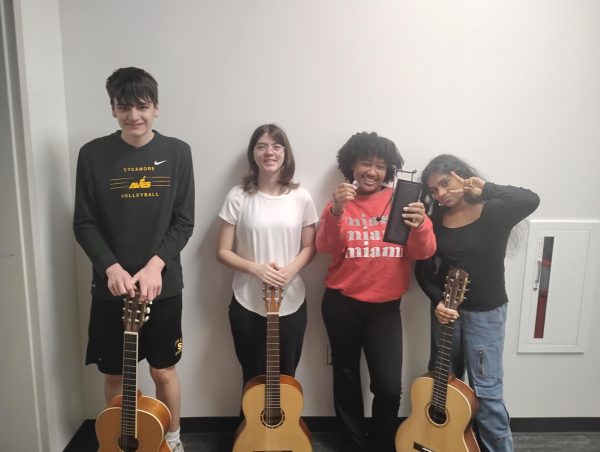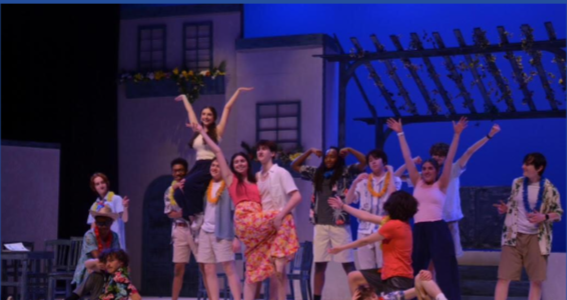Blue candy buckets help more children enjoy Halloween
RAISING AWARENESS. This Halloween, many trick-or-treaters who are nonverbal or have autism will use a blue candy bucket to raise awareness. Children who are nonverbal often struggle with trick-or-treating because the houses they visit expect them to say “trick or treat.” The idea for the blue bucket came from a mother of a child with nonverbal autism who hopes to make Halloween easier and more fun for her son and other children. Other inclusive initiatives for Halloween include the Teal Pumpkin Project, which encourages people to provide safe non-food treats for children with food allergies. “I’ve seen a lot about [the blue buckets] on social media, which also gives me hope that things in general in our country are becoming more inclusive,” said Ms. Lydia Dogget, speech-language pathologist at SHS.
The typical scene of Halloween: kids in costumes running around the streets, knocking on doors and exclaiming the well-known phrase: “trick or treat!” But for some kids, that phrase can make enjoying the holiday difficult.
Children with autism or who are nonverbal often struggle on Halloween because they are expected to say “trick or treat” at each house they visit.
Omairis Taylor, the mother of a 3-year-old boy with autism, proposed the idea of blue Halloween buckets in a post on Facebook. She explained in the post that her son is nonverbal and that “last year houses will wait for him to say TRICK OR TREAT in order for him to get a piece of candy and there I go explaining the situation for the next 5 blocks.”
Taylor decided that her son will use a blue candy bucket to signify that he has autism, and invited others to do the same.
The post went viral, and now thousands of parents plan to use blue Halloween buckets for their kids who have autism in order to make the holiday more enjoyable, as well as to raise autism awareness.
“A lot of times for kids that are nonverbal and their families, there seems to be this really big gap or divide, where a lot of the times they feel cut off from things that other kids can do, and so I think that any way that they can modify things and make those kids feel included, I think that’s really important to them,” said Ms. Lydia Doggett, speech-language pathologist at SHS.
The blue bucket movement has helped inform people if they see someone carrying a blue Halloween bucket while trick-or-treating, the child prefers to just receive candy without being encouraged to say “trick or treat.”
“I’ve seen a lot about it on social media, which also gives me hope that things in general in our country are becoming more inclusive…I think it’s really awesome that people are kind of stepping back and understanding other people might not have the same abilities, they might have different abilities and it doesn’t make them ‘lesser than’,” Doggett said.
Another recent initiative to help more kids enjoy Halloween is the Teal Pumpkin Project. This movement was started by the organization Food Allergy Research and Education (FARE) and encourages people to set out a teal-painted pumpkin with a bowl of non-food toys and items, in addition to their regular candy bowl.
The Teal Pumpkin Project allows children with food allergies—who often cannot eat the Halloween candy offered to them—to safely participate in the festivities of trick-or-treating.
Overall, these inclusive initiatives allow more children to have a happy Halloween.
Sources:
Your donation will support the student journalists of Sycamore High School. Your contribution will allow us to purchase equipment and cover our annual website hosting costs.


![RAISING AWARENESS. This Halloween, many trick-or-treaters who are nonverbal or have autism will use a blue candy bucket to raise awareness. Children who are nonverbal often struggle with trick-or-treating because the houses they visit expect them to say “trick or treat.” The idea for the blue bucket came from a mother of a child with nonverbal autism who hopes to make Halloween easier and more fun for her son and other children. Other inclusive initiatives for Halloween include the Teal Pumpkin Project, which encourages people to provide safe non-food treats for children with food allergies. “I’ve seen a lot about [the blue buckets] on social media, which also gives me hope that things in general in our country are becoming more inclusive,” said Ms. Lydia Dogget, speech-language pathologist at SHS.](https://shsleaf.org/wp-content/uploads/2019/11/mcelroy_trends_bluehalloweenbucket_photo-600x900.jpg)







